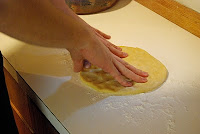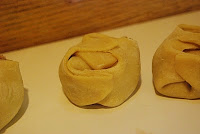Mantı are typically filled with a beef or lamb mixture, similar to the boreks from earlier, and steamed until the dough wrapper and the ground meat inside are cooked. Many regional varieties exist, as the dish spread across its geographic area with nomadic tribes. Most are served with a yogurt-garlic sauce, sometimes with sumac, hot red pepper powder, or dried mint, sometimes with other sauces and spices.
Pasta dough is a simple item to prepare. Simple by hand, and simpler by utilizing some kind of mechanism like a food processor or electric mixer. There are four ingredients:
Flour
Egg
Salt
Oil
Sometimes, if there is a need for additional moisture in the dough, a small amount of water can be added.
A filling for this dumpling can be made in any number of styles. I have found recipes for everything from beef to pumpkin manti. Potatoes, rice, vegetables, and a variety of spices are added to or substituted for the ground meat that is traditionally the filling; the one constant seems to be minced onion.
Mantı
1 lb (454 g) flour
4 eggs
pinch salt
1 fl oz (30 ml) water
1 fl oz (30 ml) oil, preferably olive
1 lb (454 g) ground beef
1 large onion, minced or ground
1/2 tsp (2.5 ml) cumin
1/2 tsp (2.5 ml) hot paprika
1/2 tsp (2.5 ml) dried parsely or 1 1/2 tsp (7.5 ml) fresh parsley, finely chopped
Ground black pepper
Salt
1. Mix dough by placing eggs, salt, water, and oil in the bowl of a food processor; pulse briefly to mix, then begin adding flour by four additions, processing then adding more flour each time. Once all flour is in, process until the dough looks like cous-cous, and is warm. (You may also make the dough by hand, or in a stand mixer. Directions are available for both methods online, but the general concept remains the same: combine all ingredients until elsastic and smooth.
2. Turn it out onto a floured counter, and knead until elastic and smooth. Set aside and rest for 20 minutes, minimum.
3. Combine onion (including its juices,) ground beef, spices, and seasonings, and mix well. Set aside to chill in the refrigerator for 15 to 20 minutes.
4. Roll out the dough to a thickness of just less than 1/8 inch (2-3 mm). Cut into 4.5 inch squares.
 |
Begin by working the dough with your fingertips... |
 |
| ...then move to a rolling pin. |
 |
| The rough thickness you seek. |
6. Fold up in the following manner:
 |
| Step 1: Meat on Squares |
 |
| First, two corners... |
 |
| ...then the other two. |
 |
| Then fold the new corners together to close up the dumpling. |
8. Remove dumplings from steamer and set to rest for 5 minutes. If you cut into them right away, all the liquid inside will run out, and you'd prefer that it be re-absorbed into the meat filling.
9. Serve sprinkled with black pepper, sumac, or paprika (or a combination thereof) with your choice of sauces—I prefer the yogurt-garlic sauce, but I suspect our old friend paprika butter would be delicious, too.
I made a sauce for some left-over filling (which I formed into patties and sautéd,) the said sauce consisting of about a pint-and-a-half to a quart of quartered grape tomatoes, half a large onion medium diced, some olive oil, a clove of garlic, hot and sweet paprika, salt, black pepper, oregano, sumac, and fresh lemon juice. I didn't really measure anything, so much as add here and there. I first began by sautéing the onions over high heat, then, when they were softened and translucent, added the tomatoes. I reduced the heat to a medium-high state, and continued cooking. When those got soft enough to slough their skins, I began seasoning and cooking them down. I added the lemon juice last. Season to taste at the end, and if necessary cook further to get the flavors right. I didn't take any pictures, sadly, because it was just so tasty that it didn't last long enough to be photographed.



This recipe looks great! The manti I had in turkey were really tiny, and I never would have thought to try them because it seemed like too much work.
ReplyDeleteDo you have a recipe for the yogurt sauce?
The manti can absolutely be made smaller. They'd steam for less time, obviously, but otherwise be made more or less the same.
ReplyDeleteFor a yogurt-garlic sauce, mince up fresh garlic in a food processor or by hand, and combine with greek yogurt (it's somewhat thicker and makes for a better sauce.) The amount varies, of course, based on your taste for garlic. Start with 1-2 tsp per cup of yogurt.
The most important thing is to let the sauce sit... it gets stronger as it does. 2 hours in the fridge will get a good approximation of the strength.
Appreciate this blog ppost
ReplyDelete